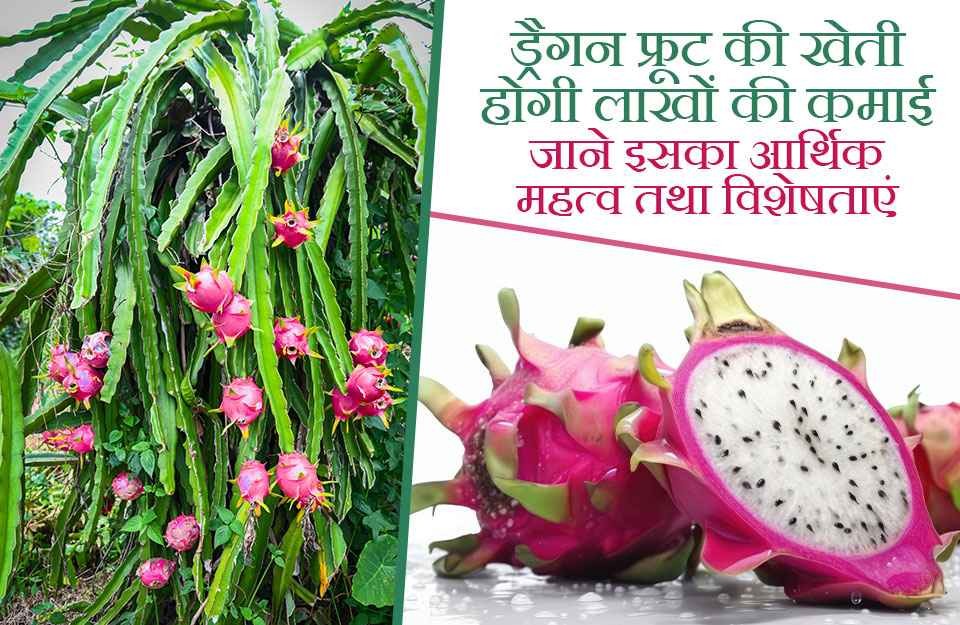
The dragon fruit, a rapidly growing cactus reminiscent of a bell, is also known by several names including "Chandni Night Fulling," "Serious Strawberry," "Pier Belle of the Night," and "Candelabra Plant." Its cultivation spans across countries such as Malaysia, Taiwan, Indonesia, Thailand, Sri Lanka, Bangladesh, and Vietnam. Now, India has also taken up dragon fruit cultivation. Renowned for its highly nutritious and delightful taste, dragon fruit offers significant health benefits owing to its rich content of vitamins, minerals, fiber, protein, and other essential nutrients. The red pitahaya variety is cultivated on a large scale.
Belonging to the Cactaceae family, dragon cacti are succulent plants thriving in high mountains, hot, humid, and arid regions. In India, their aesthetic appeal due to vibrant flower colors makes them popular choices for garden cultivation or pot adornment at homes, either for decorative purposes or as a hobby. Dragon plants exhibit slow growth but sustain vitality for extensive periods. Propagation is achieved through cuttings. Approximately 25 species of dragon fruit have been identified, ranging in size from as diminutive as three inches to towering heights of 70 feet. The largest among them, Saguaro, abounds in the rocky canyons and mountains of Southwestern America, while the smallest, Mammillaria Fraileana, is as small as a thumb.
Effective dragon fruit cultivation relies on the spacing between plants and the provision of adequate support, typically through wooden structures. Rows should be positioned 2 to 3 meters apart, accommodating 2000 to 3750 plants per hectare. Employing the columnar method, plants can yield fruit in less than a year. Planting is facilitated using columns measuring 20 cm in length, which are inserted into pots filled with a mixture of farmyard manure and sandy soil in a 1:1:2 ratio. In orchards, plants should be spaced 2x2 meters apart, with pits measuring 60 cm in size. These pits are filled with compost and supplemented with 100 grams of superphosphate.
Dragon fruit thrives in a range of temperature conditions, but tropical climates are best suited for its growth. Cultivation is feasible in areas with modest rainfall (50-60 cm) and temperatures between 25-30 degrees Celsius. Some varieties can even withstand higher temperatures, enduring up to 40 degrees Celsius.
Ideal soil for cultivating dragon fruit is sandy loam, enriched with organic matter and possessing excellent drainage. Soil pH should ideally fall between 5.5 and 7.
Fertilization and Irrigation Practices: Both mineral and organic fertilizers contribute significantly to the robust growth of dragon fruit. Each plant requires an annual application of 12-15 kilograms of organic fertilizer to thrive optimally. During the fruiting stage, a generous dose of potassium coupled with a modest nitrogen supply is recommended.
Despite its resilience to low rainfall and extended dry spells, consistent irrigation is essential for achieving high yields in dragon fruit cultivation. Regular watering plays a crucial role in maintaining adequate moisture levels, particularly during flowering and fruit development stages, thereby enhancing overall productivity.
Economic Significance and Distinctive Features of Dragon Fruit: Mexico, dried dragon fruits are a staple, and they're also mashed for infants' consumption. Moreover, dragon fruit peels find utility; some of their spines are long and robust enough to serve as needles for gramophones and alpine plants. Certain dragon varieties even serve as fuel. In India, they're predominantly cultivated for decorative purposes or for their striking flowers in gardens or potted plants at homes. These flowers showcase a spectrum of hues, including white, yellow, red, blue, and more. Some dragon plants exhibit disease-resistant behavior. Additionally, water can be extracted from their stems to quench thirst.
Most cacti lack leaves or thorns; instead, their stems are thick, fleshy, and resemble snakes. These stems bear numerous thorns, some of which are sharp enough to function as needles for gramophones or alpines. Dragon fruit plants come in various forms, such as bell-shaped, globular, columnar, and clustered. The majority of them are leafless, but where leaves exist, they are minuscule. Some of their flowers are notably large and vibrant, attracting attention with their diverse colors, including white, yellow, blue, red, and various other shades. While some flowers are elongated tubes, others are shorter in stature.
Benefits of Dragon Fruit: Consuming dragon fruit aids in boosting the body immunity and alleviating issues like constipation. Not only does it offer health benefits, but it also caters to numerous skincare needs. For instance, its abundant vitamin C content helps in eradicating facial blemishes. Its anti-inflammatory properties contribute to reducing skin irritation and allergic reactions. Furthermore, the presence of vitamin C promotes collagen production, fortifies hair, and prevents breakage.
Dragon Fruit Harvesting and Yield: The color of dragon fruit skin undergoes a gradual change over time, shifting from green to red or pink around 25 to 27 days after flowering. The initial harvest usually commences 18 months after planting the cuttings. Flowering spans from 27 to 33 days. The yield varies based on plant density, ranging between 15 to 30 tons per hectare. Harvesting poses a challenge due to the lack of thorns.